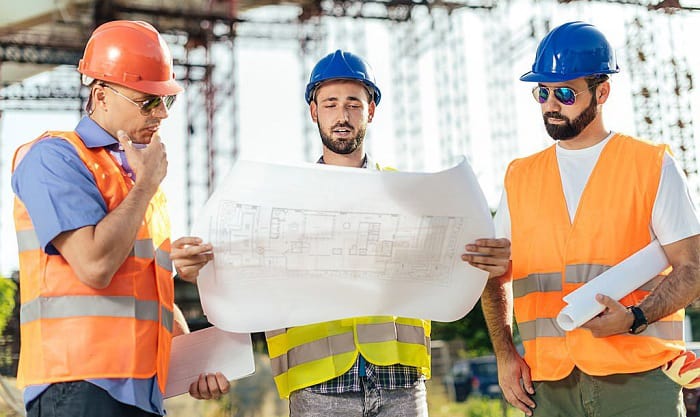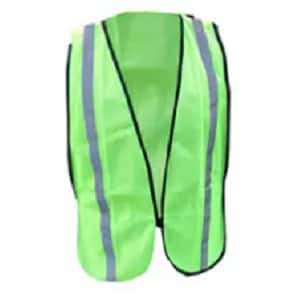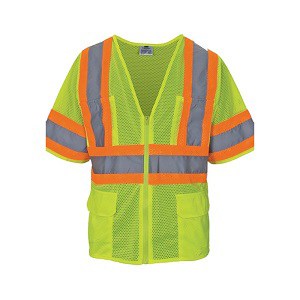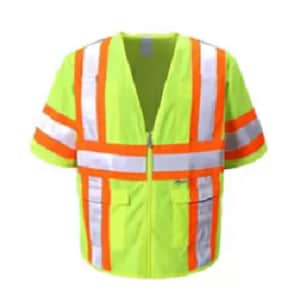Wearing safety vests makes workers distinguishable in low visibility situations. When buying a vest, you may see the words “Class 1,” “Class 2” or “Class 3” on the product descriptions.
So, what’s the difference between Class 1, 2, and 3 safety vests?
Essentially, this classification corresponds to the levels of reflectivity and contrast appropriate to specific work settings. This allows everyone to see workers during nighttime or in bad weather conditions.
Table of Contents
3 Types of Safety Vests
To help you determine the type of safety vest to wear, let’s compare the high visibility clothing Class 1, 2, and 3. The guide I’m sharing below is based on the safety standards set by experts in different fields, including the American National Standards Institute (ANSI) and Occupational Safety Health Standards (OSHA).
Class 1
A Class 1 safety vest must have at least 155 square inches of reflective tape. Specifically, the reflective tape can be 9.39 linear feet of 1 ⅜ inches or 6.46 linear feet of 2 inches. This tape is wrapped around the waist and above both shoulders.
The amount of reflective material on the vest allows you to distinguish the person wearing it from the environment. It is suitable for workers who are at a safe distance from road traffic.
In this OSHA PDF, warehouse workers and delivery drivers are two examples of professions that require Class 1 safety vests.
Class 2
According to PK Safety’s explanation, the ANSI Class 2 vest must feature a reflective tape of at least 201 square inches. The reflective material can be 12.2 linear feet of 1 3/8-inch tape or 8.373 linear feet of 2-inch tape.
In short, Class 2 safety vest requirements have to meet workers’ need for 360-degree visibility. As such, the reflective tape is placed around the back, waist, chest, and shoulders.
Just to give you an idea, a Class 2 vest is suitable for jobs like emergency first responders, utility workers, surveyors, and road construction workers.
The visibility and reflectivity of a Class 2 safety vest are suitable for workers who are typically close to vehicles moving at a speed that exceeds 25 mph. In such situations, their attention is focused on the task at hand rather than an approaching vehicle.
Another reason to use this vest is extreme weather conditions. Heavy rains and fog can dramatically reduce visibility. Also, check this guide to find out the list of top-rated high-visibility rain gear here!
First responders, for instance, can wear a Class 2 vs Class 3 vest. The choice of safety vest types will depend on the level of risk that they face in an emergency.
Class 3
ANSI Class 3 vests are geared toward providing workers with maximum visibility. As pointed out in this article by Protective Masks Direct, they always feature reflective tapes of at least 310 square inches.
Following the Class 3 vest requirements, the dimensions of the tape should be 12.92 linear feet and 2-inches wide. Apart from the shoulders, waist, and back, the reflective material should also be placed on the arms. In some cases, even the worker’s legs should be visible.
Under extremely low visibility scenarios, people should be able to see the silhouette of the worker wearing a Class 3 safety vest. Therefore, this protective equipment is recommended for flaggers, utility workers, and railroad workers.
Conclusion
As studies have shown, poor visibility is among the causes of workplace accidents, but this can be avoided if precautions are taken. One way is to wear a safety vest when on duty.
In this article, I’ve answered one of the most common questions that workers have: “What’s the difference between class 1, 2, and 3 safety vests?”
It can be hard to memorize all the details that the ANSI and OSHA have provided in their safety protocols. In any case, here’s what you need to remember: A higher number corresponds to a higher degree of visibility and reflectivity.

Veronica is our content editor. She is a talent in delivery. Her main work is editing and writing articles that are both informative and simple to follow. She is in charge of synthesizing our understanding of what personal protection equipment (PPE) is needed in each job, how to best apply it, and how to visualize that equipment.






